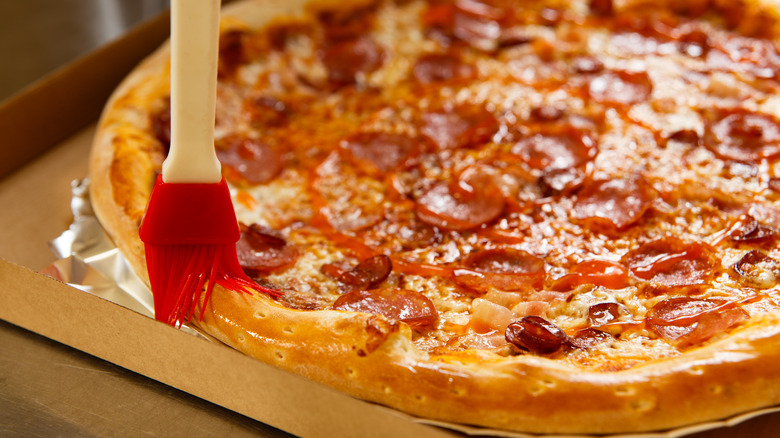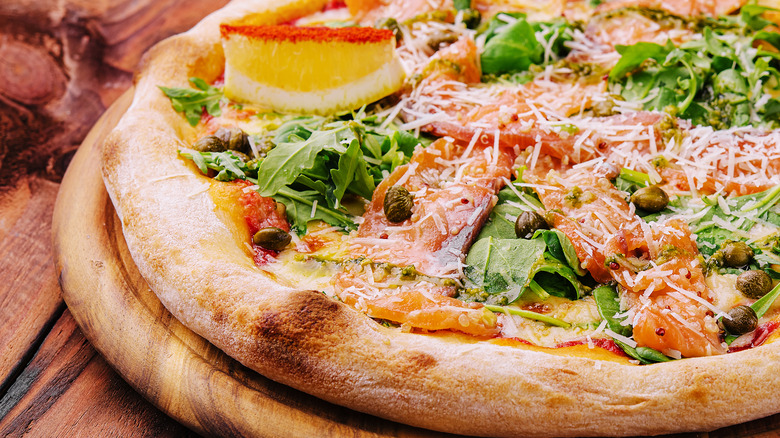If You're Not Seasoning Your Frozen Pizza Crust, What Are You Doing?
A frozen pizza is many things: It is late-night hunger pangs fixed in minutes, every impoverished university student's means of survival, an emergency dinner sitting in every kitchen's freezer, and an effortless meal to put on the table when you can't be bothered to cook much else. Plus, with a frozen pizza stocked in your refrigerator, you always have that saucy, cheesy, doughy goodness ready on the go.
The joys of frozen pizza are many — but let's be honest, it tends to fall short in one particular department: Soggy and bland at best, frozen pizzas are not exactly known for their wonderfully scrumptious crusts. But rather than nibbling your way around those doughy edges only to throw them away later, why not season the crusts and make things more enjoyable? Look towards your rack of seasoning — there are chili flakes to add spice to your frozen pizza crust or everything bagel seasoning for crunch. A sprinkle of parmesan can upgrade the cheese factor and a dusting of garlic or onion powder will add layers of savory depth to the crust. Frozen pizza crusts really don't have to be all that bland and lackluster — they only need to be seasoned.
Butter and oil are a frozen pizza crust's best friends
There are plenty of seasonings that can upgrade frozen pizza crusts — whether it's the usual Italian suspects like dried oregano, chili flakes, and basil; staples like paprika, garlic, and black pepper powder; or more creative spices like curry powder or dill. No matter which seasonings you choose, what you're definitely going to need is the help of a little olive oil or butter. Butter and olive oil not only add their own flavor to the crust, but they will also help the dough brown as it bakes, subsequently giving it the air of freshly baked bread. The butter itself can be turned into homemade garlic butter compound with the help of minced garlic, which can then be smeared onto the frozen pizza crust instead.
Melted butter or olive oil can be brushed either before the frozen pizza goes into the oven or once it's already baked, after which you can sprinkle the seasonings on top. The only thing to keep in mind is that the smoke points of refined olive oil and butter are 465 and 350 degrees Fahrenheit respectively, which means the fats may burn if they are exposed to the high temperatures of the oven for too long. If you're baking at scorching heat, it may be wiser to wait till the pizza is roughly five minutes away from being entirely cooked to add your fat and spices.
Don't limit the seasoning to just the crust
Although seasoning the frozen pizza crust will do wonders to upgrade the edges of the dough, you don't have to stop just there — the entire pie could do with the help of extra flavoring. Good quality olive oil, for example, though excellent on the crust in particular, can be drizzled all over the cooked frozen pizza. A squeeze of lemon juice, fresh lemon zest, or citrus-infused oil can also add a much-needed pop of brightness to bring your pie to life. Or, if you have the appetite for pizzas on the spicier side, consider spiking a tablespoon or two of sweet honey with a dash of hot sauce and pouring that over the pizza instead.
Even the seasonings — chilies, garlic, dry herbs, and spices — can go all over the frozen pizza. And don't stop at dried spices, either — upgrade months-old frozen pie with fresh ingredients. Add marinated vegetables like peppers and onions — or go fresh with leafy greens like spinach, proteins like fish or chicken, and cheeses like burrata or just-grated parmesan on top. Juicy fruits like figs and peaches are fantastic too — if fruit-on-pizza floats your boat, that is. There's also the option of cracking an egg or two for that creamy, yolky richness on your pizza. There are so many delicious ways to season a frozen pizza that it would almost be a shame not to!



